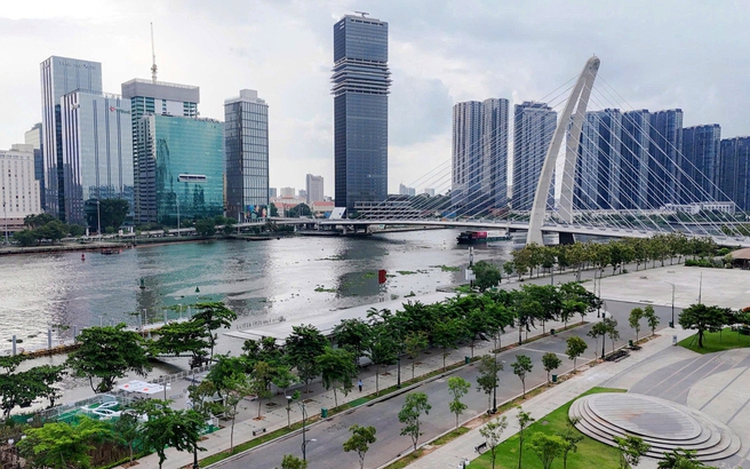
The areas along both banks of the Saigon River in Ho Chi Minh City—the former District 1 (background) and the Thu Thiem area (foreground)—are expected to form the core of the city’s future international financial center. Photo: Chau Tuan / Tuoi Tre
The submission outlines the designated sites and key operational mechanisms and policies proposed for the IFCs.
This follows the passage of Resolution 222/2025 by the National Assembly on June 27, which will take effect on September 1, providing the legal framework for the establishment, operation, management, supervision, and special policy regimes of both IFCs.
In Ho Chi Minh City, the IFC is expected to span approximately 686 hectares, encompassing the former District 1 on one side of the Saigon River and the Thu Thiem area on the opposite bank, the ministry said.
To accelerate infrastructure development, the proposal recommends special mechanisms for Thu Thiem, including rapid deployment of urban rail, pedestrian bridges, river buses, ports, and other critical systems.
Within this area, Functional Zone 1 will be established as a core zone, aimed at attracting strategic investors during the initial phase of the IFC.
In Da Nang, the IFC is set to be headquartered in the ICT building within Software Park 2, supported by major future infrastructure projects such as the Da Nang International Data Center, a submarine cable landing station, Lien Chieu Port, and the expansion of Terminal 2 at Da Nang International Airport.
Additional investments—including expanded 5G coverage; smart computing servers; monitoring systems; and management platforms—will support the IFC’s digital and technological backbone.
Operationally, each IFC will specialize in different areas.
Ho Chi Minh City will focus on capital markets, banking, money market products, fintech regulatory sandboxes, specialized trading platforms, and a commodities market.
Da Nang will emphasize green finance, fintech applications, digital services, and controlled experiments with digital assets, cryptocurrencies, and payment systems.
Both hubs aim to attract a wide range of investment vehicles, including remittance funds and small to medium fund management firms.
To operationalize the IFCs, the Ministry of Finance has recommended that the government issue several decrees by the end of this year.
These decrees will provide detailed guidance on policies related to taxation, customs, immigration, land use, construction, labor, dispute resolution, and other areas essential for establishing and operating the centers.
Businesses operating within the IFCs will enjoy significant fiscal incentives under Resolution 222/2025, the ministry stated.
Enterprises launching new investment projects in priority industries at an IFC will qualify for a corporate income tax (CIT) rate of 10 percent, applicable for 30 years.
Additionally, they are eligible for a full tax exemption for up to four years, followed by a 50-percent reduction in payable tax amounts for no more than the subsequent nine years.
Projects outside priority sectors will receive a CIT rate of 15 percent for 15 years, with a full exemption for no more than two years and a 50-percent reduction for up to four years thereafter.
Salaries of both Vietnamese and foreign professionals working within the IFCs will be exempt from personal income tax through 2030.


Max: 1500 characters
There are no comments yet. Be the first to comment.